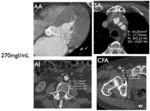Purpose
Transcatheter aortic valve implantation (TAVI) is a recently developed,
minimally invasive technique for percutaneous prosthetic replacement of the aortic valve in patients with symptomatic severe aortic valve stenosis who are ineligible to surgery due to excessively high surgical risk.
Multidetector computed tomography angiography (CTA) plays a pivotal role for TAVI planning,
allowing to quickly assess the morphology of the aortic annulus and the patency of vascular accesses for optimal prosthesis sizing and deployment.
TAVI patients are at higher risk for contrast-induced nephropathy (CIN) due to...
Methods and Materials
Fifty consecutive nonobese patients (body mass index 21.5 ÷ 28.2 kg/m2) underwent CTA for TAVI planning on a high definition 64-row scanner (Discovery CT750 HD™,
General Electric,
Milwaukee,
WI).
In the first 27 consecutive patients (54%) an overall volume of 75-90mL of iodixanol 270mgI/mL (Visipaque 270™,
GE Healthcare,
Chalfont St.
Giles,
UK) was injected intravenously at 4-6mL/s flow rate,
whereas in the remaining 23 (46%) the same volume of iodixanol 320mgI/mL (Visipaque 320™,
GE Healthcare) was administered at 3.5-5mL/s flow rate.
All CTA examinations were...
Results
Mean arterial density was comparable between iodixanol 270mgI/mL and 320mgI/mL at all vascular levels (AA 398±31 vs 387±83 HU,
SA 394±65 vs 400±87 HU,
CFA 387±114 vs 385±85 HU,
and AI 410±88 HU vs 403±92 HU,
respectively; p>0.05) ( Table 2 ).
Image quality was diagnostically acceptable in all cases and comparable between theiodixanol 270mgI/mL(Fig. 1,Fig. 2) and the iodixanol 320mgI/mL ( Fig. 3 , Fig. 4 )groups,
as well as contrast injectionpressure(114±42 vs 121±54 psi,
p>0.05).
Iodine load was significantly lower in the iodixanol...
Conclusion
In nonobese patients undergoing CT angiography for TAVI planning,
an iodine concentration as low as 270mgI/mL yields noninferior arterial enhancement and subjective image quality compared with the same volume of 320mgI/mL contrast medium,
along with the advantage of a significantly lower iodine load.
Our findings may form the basis for further studies involving the use of faster CT scanners,
lower tube voltage settings,
and more efficient iterative image reconstruction algorithms as enabled by the latest CT technology,
potentially allowing for a more aggressive reduction in...
References
Achenbach S,
Delgado V,
Hausleiter J,
Schoenhagen P,
Min JK,
Leipsic JA.
SCCT expert consensus document on computed tomography imaging before transcatheter aortic valve implantation (TAVI)/transcatheter aortic valve replacement (TAVR).
J Cardiovasc Comput Tomogr 2012;6:366-380
Behrendt FF,
Pietsch H,
Jost G et al.
Intra-individual comparison of different contrast media concentrations (300 mg,
370 mg and 400 mg iodine) in MDCT.
Eur Radiol 2010;20:1644-1650
Behrendt FF,
Pietsch H,
Jost G et al.
Identification of the iodine concentration that yields the highest intravascular enhancement in MDCT angiography....





